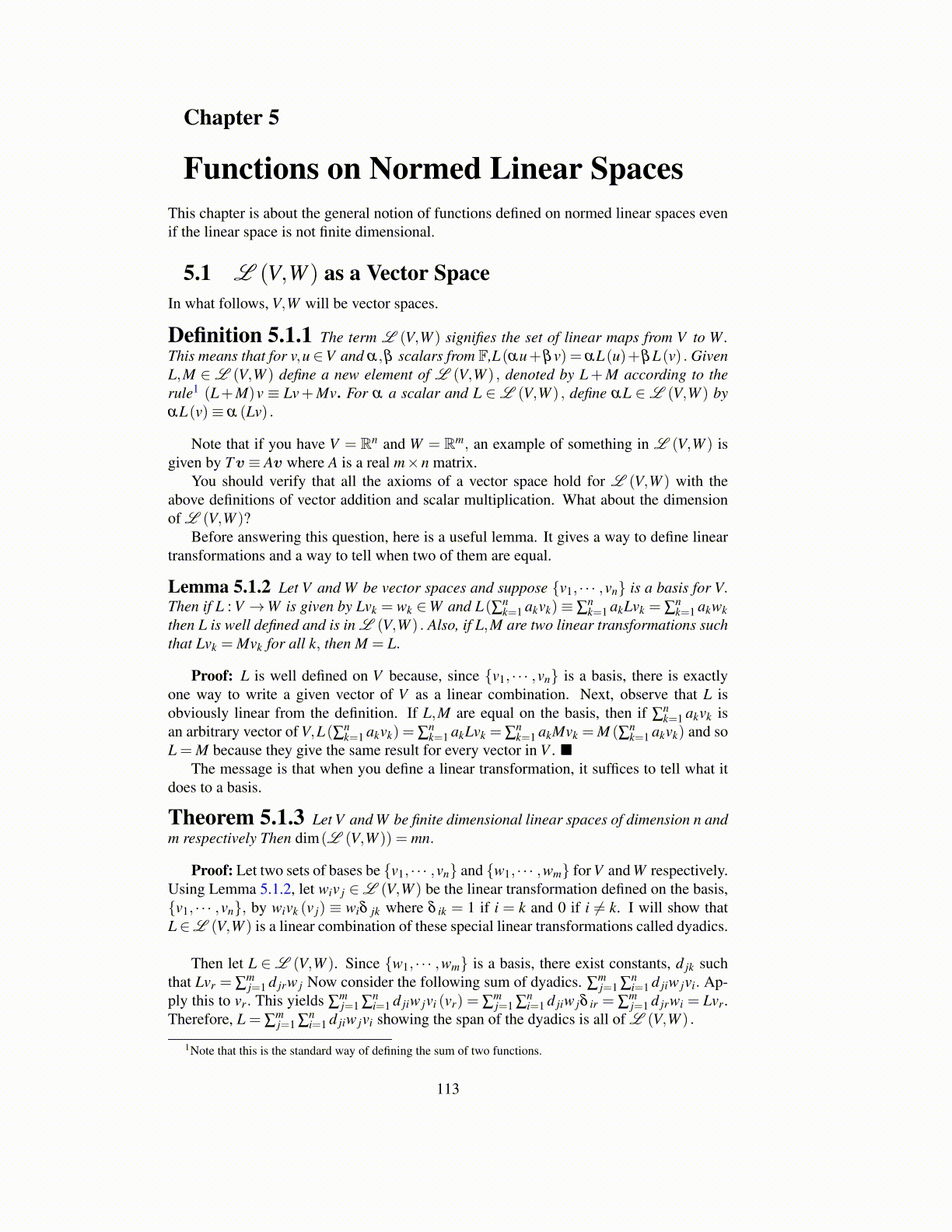
Chapter 5
Functions on Normed Linear SpacesThis chapter is about the general notion of functions defined on normed linear spaces evenif the linear space is not finite dimensional.
5.1 L (V,W ) as a Vector SpaceIn what follows, V,W will be vector spaces.
Definition 5.1.1 The term L (V,W ) signifies the set of linear maps from V to W.This means that for v,u∈V and α,β scalars from F,L(αu+βv) = αL(u)+βL(v) . GivenL,M ∈ L (V,W ) define a new element of L (V,W ) , denoted by L+M according to therule1 (L+M)v ≡ Lv+Mv. For α a scalar and L ∈L (V,W ) , define αL ∈L (V,W ) byαL(v)≡ α (Lv) .
Note that if you have V = Rn and W = Rm, an example of something in L (V,W ) isgiven by Tv ≡ Av where A is a real m×n matrix.
You should verify that all the axioms of a vector space hold for L (V,W ) with theabove definitions of vector addition and scalar multiplication. What about the dimensionof L (V,W )?
Before answering this question, here is a useful lemma. It gives a way to define lineartransformations and a way to tell when two of them are equal.
Lemma 5.1.2 Let V and W be vector spaces and suppose {v1, · · · ,vn} is a basis for V.Then if L : V →W is given by Lvk = wk ∈W and L(∑n
k=1 akvk)≡ ∑nk=1 akLvk = ∑
nk=1 akwk
then L is well defined and is in L (V,W ) . Also, if L,M are two linear transformations suchthat Lvk = Mvk for all k, then M = L.
Proof: L is well defined on V because, since {v1, · · · ,vn} is a basis, there is exactlyone way to write a given vector of V as a linear combination. Next, observe that L isobviously linear from the definition. If L,M are equal on the basis, then if ∑
nk=1 akvk is
an arbitrary vector of V,L(∑nk=1 akvk) = ∑
nk=1 akLvk = ∑
nk=1 akMvk = M (∑n
k=1 akvk) and soL = M because they give the same result for every vector in V . ■
The message is that when you define a linear transformation, it suffices to tell what itdoes to a basis.
Theorem 5.1.3 Let V and W be finite dimensional linear spaces of dimension n andm respectively Then dim(L (V,W )) = mn.
Proof: Let two sets of bases be {v1, · · · ,vn} and {w1, · · · ,wm} for V and W respectively.Using Lemma 5.1.2, let wiv j ∈L (V,W ) be the linear transformation defined on the basis,{v1, · · · ,vn}, by wivk (v j) ≡ wiδ jk where δ ik = 1 if i = k and 0 if i ̸= k. I will show thatL∈L (V,W ) is a linear combination of these special linear transformations called dyadics.
Then let L ∈L (V,W ). Since {w1, · · · ,wm} is a basis, there exist constants, d jk suchthat Lvr = ∑
mj=1 d jrw j Now consider the following sum of dyadics. ∑
mj=1 ∑
ni=1 d jiw jvi. Ap-
ply this to vr. This yields ∑mj=1 ∑
ni=1 d jiw jvi (vr) = ∑
mj=1 ∑
ni=1 d jiw jδ ir = ∑
mj=1 d jrwi = Lvr.
Therefore, L = ∑mj=1 ∑
ni=1 d jiw jvi showing the span of the dyadics is all of L (V,W ) .
1Note that this is the standard way of defining the sum of two functions.
113